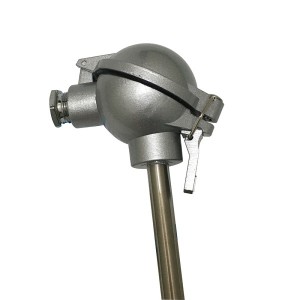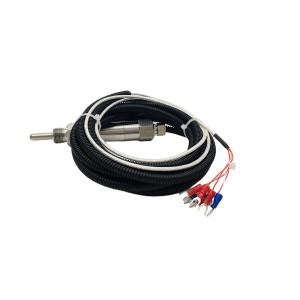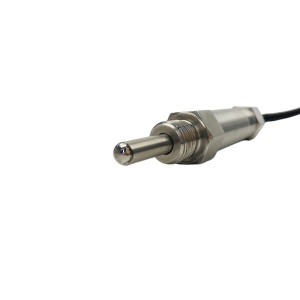In industrial production, temperature measurement is crucial for ensuring equipment stability and product quality. As core temperature sensors, RTDs are used across nearly all heavy industries, including petrochemicals, power generation, and metallurgy. The WZPM2-08-67.5-M18-B PT100 platinum RTD thermal resistance is the preferred choice in many applications due to its high accuracy and strong stability. In long-term use, it can help companies save significant money by reducing downtime and maintenance frequency. Next, we will analyze the technical advantages and economic value of the WZPM2-08-67.5-M18-B RTD from three perspectives: structural design, application scenarios, and cost-effectiveness, to clarify its cost-saving logic.
I. Appearance Differences in RTDs: Not All RTDs Are Suitable for Harsh Working Conditions
Common RTDs generally utilize a “thin-rod probe + simple junction box” design. Their core advantages are lightweight and low-cost, making them suitable for routine temperature measurement applications with low pressure and low vibration, such as pipe temperature measurement in ordinary workshops. However, in harsh environments like high-pressure reactors and high-speed compressors, ordinary RTDs are prone to failure. The key difference between the heavy-duty thermal resistance WZPM2-08-67.5-M18-B and ordinary RTDs lies in its “reinforced structure.” Every design detail addresses the pain points of industrial sites:

Thickened RTD Body: The WZPM2-08-67.5-M18-B RTD body is constructed of corrosion-resistant materials such as 316L stainless steel and Hastelloy, rather than thin metal. Its wall thickness is 2-3 times that of ordinary RTDs, allowing it to withstand pressures up to 10 MPa. Even with high pressures above 50°C, the RTD body is not susceptible to deformation or breakage, even when exposed to equipment vibration or minor mechanical impact.
Standardized RTD connection structure: The RTD connection utilizes a multi-section hexagonal structure with standardized mechanical interfaces, ensuring a secure connection to the equipment during installation. This prevents the RTD from loosening or shifting due to equipment vibration, thereby preventing inaccurate temperature measurement data.
Upgraded RTD cable protection: The RTD WZPM2-08-67.5-M18-B’s tail cable is encased in metal or rubber bellows, providing both stretch resistance and resistance to wear from dust and oil on-site. Even in the complex wiring environment of a workshop, the RTD cable is less susceptible to scratches and degradation.
II. The Core Advantage of Heavy-Duty RTDs: Designed to Solve Troubleshooting Problems in Harsh Working Conditions
High pressure, strong vibration, and corrosive media found in industrial sites are natural enemies of conventional RTDs. The heavy-duty RTD WZPM2-08-67.5-M18-B is designed to address these challenges, reducing RTD failures and ensuring more stable temperature measurement. Pressure and vibration resistance extend the life of RTDs: In high-pressure pipelines, reactors, and compressors, the thin probes of conventional RTDs are easily deformed by the high-pressure media or broken by equipment vibration, often requiring replacement every 1-3 months. Heavy-duty RTDs, however, feature thick-walled housings that withstand high-pressure shocks, and a built-in spring-loaded temperature sensor holder absorbs vibration energy. A domestic chemical company replaced standard plug-in RTDs with heavy-duty RTDs (WZPM2-08-67.5-M18-B) in a chlor-alkali reactor. The RTD probe life was extended from one month to 18 months, with zero failures during that time, saving nearly 10,000 yuan in replacement costs.

Sealed protection isolates RTDs from contaminants: Dust, moisture, and corrosive liquids found in industrial environments can easily penetrate the junction boxes or probe gaps of conventional RTDs, causing short circuits, resistance drift, and ultimately, temperature measurement failure. The WZPM2-08-67.5-M18-B Thermal Resistance features a multi-stage sealing design, achieving an IP68 protection rating and effectively keeping out all contaminants.
III. Reducing Downtime: How to Calculate the Hidden Value of Thermal Resistances?
For industrial enterprises, the cost of equipment downtime far exceeds the procurement cost of thermal resistances. For example, a 660MW power plant previously experienced unit downtime losses exceeding 50,000 yuan per hour due to a broken wiring connection in a conventional Thermal Resistance. In the chemical industry, a reactor failure due to a Thermal Resistance’s temperature measurement failure resulted in the scrapping of the entire reactor’s raw materials, resulting in losses reaching hundreds of thousands of yuan per event. Heavy-duty Thermal Resistances, however, reduce downtime by turning these “hidden losses” into “real benefits.” The specific savings can be calculated from three dimensions:
Extending the Thermal Resistance maintenance cycle and reducing planned downtime: Conventional Thermal Resistances, exposed to strong vibration and high-pressure environments, need to be removed, replaced, and calibrated every three months. Heavy-duty Thermal Resistances, however, can extend their maintenance cycle to one to three years, reducing maintenance costs. A chemical plant previously shut down for two hours each month to replace Thermal Resistances, amounting to 24 hours of downtime per year. After switching to heavy-duty Thermal Resistances, this reduced downtime by 24 hours per year. Assuming the plant’s hourly output value is 100,000 yuan, this alone increases annual revenue by 2.4 million yuan.
Improving Thermal Resistance reliability eliminates unplanned downtime: The cost of unplanned downtime is 3-5 times that of planned downtime. Conventional Thermal Resistances are prone to sudden failure under harsh operating conditions, such as corrosion leaks and probe breakage, which can directly lead to emergency equipment shutdowns. Heavy-duty Thermal Resistances, however, are extremely stable. After 2,000 hours of continuous operation on a 200Hz vibration table, the resistance drift of the Thermal Resistances was only ±0.1Ω, far less than the ±0.5Ω of conventional Thermal Resistances.
IV. Thermal Resistance selection and maintenance: How can you use them with less worry and less money?
Maximizing the value of a Thermal Resistance depends on proper selection and proper use. Even a heavy-duty structure can be prone to failure if the wrong model is chosen. Improper maintenance can also shorten the lifespan of the Thermal Resistance. When selecting an RTD, matching it to the operating conditions is key. Different operating conditions have different requirements for RTDs. Don’t blindly choose expensive ones; consider the specific scenario:

For high-pressure applications (such as high-pressure reactors and high-pressure pipelines): Choose a heavy-duty RTD with a 316L stainless steel or ceramic sheath. Ensure the RTD withstands a pressure of 10 MPa or higher.
For high-vibration environments (such as compressors, fans, and rolling mills): Prefer heavy-duty RTDs with a “shock-absorbing package,” such as a chip-type platinum RTD with an internal spring buffer, to reduce the impact of vibration on the RTD’s temperature sensing element.
For corrosive media (such as acidic and alkaline solutions, chlorine, and sulfides): Choose a RTD sheath made of a specialty material such as Hastelloy or titanium alloy to prevent corrosion.
For explosion-proof areas (such as chemical plants and oil and gas storage tank areas): RTDs must be certified for explosion-proof applications such as Ex d IIC T6 to prevent accidents caused by the RTD.
RTD Maintenance: Regular Calibration + Environmental Control: Although heavy-duty RTDs are durable, they still require routine maintenance. Three key points should be taken into consideration:
Calibration Cycle: Industrial-grade RTDs are recommended to be calibrated every 6-12 months to ensure that the RTD’s temperature measurement error is within the acceptable range.
Environmental Protection: Avoid placing the RTD WZPM2-08-67.5-M18-B near directly heated objects to prevent local overheating. RTDs used outdoors should be protected from rain and snow, and the terminal box outlet should face downward to prevent rainwater from seeping in.
Wire Management: A three-wire or four-wire RTD system is recommended to minimize the impact of line resistance on temperature measurement data. If electromagnetic interference is present on site, the RTD cable should be shielded and grounded at a single point to prevent data drift caused by electromagnetic interference.
Many companies believe that the initial investment in heavy-duty RTDs is high and uneconomical. However, this “high investment” is actually an investment in “industrial reliability.” Ordinary RTDs frequently fail under harsh operating conditions, resulting in downtime losses, maintenance costs, and material waste that far outweigh the RTD purchase cost. Heavy-duty RTDs, however, transform these “hidden losses” into “sustainable benefits” through their pressure resistance, vibration resistance, and long lifespan. For industries dependent on stable production, such as petrochemicals, power generation, and metallurgy, choosing the right heavy-duty RTD for the right conditions isn’t just a waste of money, but a savings—after all, in industrial production, “no downtime, few failures” is the ultimate value for money.
If your company is facing frequent RTD failures and high downtime losses, or is struggling to choose an RTD for challenging operating conditions like high pressure, strong vibration, or corrosion, contact us! With 20 years of experience in industrial R&D and application, we can customize a heavy-duty RTD solution tailored to your specific application. We offer comprehensive support, from RTD selection and installation guidance to regular calibration. Contact us now and let our professional team help you turn your RTD investment into a high return!
E-mail: sales@yoyik.com
Tel: +86-838-2226655
Whatsapp: +86-13618105229
Yoyik offers various types of power plants spare parts for steam turbines, generators, boilers as below:
hydraulic oil filter near me TFX-400*100 coal mill oil-return filter
hydraulic filter by size 01-388-013 regenerating filter
stainless steel pleated filter cartridge DR405EA030V/-W
stainless steel pleated filter cartridge SXU-A100*50S
10 micron stainless steel filter FX-630*40H lube oil and filter change
hydraulic steering filter HQ25.300.16Z ion-exchange resin filter
cartridge filters 0110D0100N/-V
filter assy oil HBX-250*10 filter
hydraulic filter by size DP602EA03V/W EH oil pump discharge filter sealing ring
hydraulic oil filter remover DQ600EJJHC BFP filter
water filtration companies ZCL-350 Filter element
industrial liquid filtration 13299-001V
hydraulic filter company P2FX-BH-30*3
oil filter element 21FC-5121-160-160*400-25
liquid filtration systems AP3E302-02D01V\-F
oil filter making machine TM720D-400
hydraulic filtration machine WU100*100
filter lube HQ23.32Z DUPLEX OIL FILTER
industrial oil filtration systems HC9801FHT4Z
cartridge filters 707FH3260GA10DN40H7F3.5C jacking oil system back-flushing filter
industrial filter manufacturing WJ01.95.102D
10 micron stainless steel mesh FAX 250*10 Hydraulic coupler filter
industrial fluid filtration IX-160*100 ST LUBE OIL FILTER
industrial inline filters 08E30-DCB
hydraulic oil purification machine V6021V4C03 pump discharge filter
100 mesh 200 sq in hydraulic filter AP3E301-03D03V/-F EH oil main pump discharge HP filter
filter tank hydraulic DZ903EA03V/-W
filter mesh manufacturer WNY-5P lube filter
industrial filter sales AD1E101-01D03V/-WF oil tank oil-return filter
hydraulic oil filters APIE101-01D03V/-WF
hydraulic filter kit DQ600KW25H1.0S coal mill oil-return filter
hydraulic suction line filter QF6803GA20H1.5C Filter mill
heavy equipment oil filters 0160-D-020-BN3HC
Post time: Sep-22-2025













